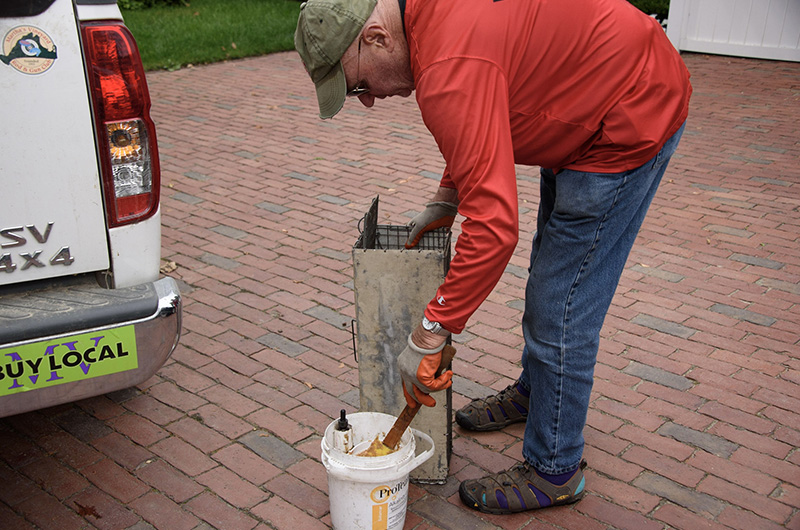Walter Wlodyka, the Island’s skunk man, knows how to make an entrance. A whiff of sulfur comes down the road, then his truck, its bed piled high with metal traps, each printed with a warning: Danger – Live Skunks. A flag waves from either side of the tailgate, the star-spangled banner and an illustrated skunk on a field of yellow.
The truck is a common sight. Mr. Wlodyka hits the road every morning to check on each of his traps he sets for clients, part of the legal requirements of a trapping permit in Massachusetts.
“This is a seven day a week job,” he said. “I do 80 to 90 miles of driving each day, up and down every dirt road…I go all around the Island in a big circle.”
Traffic management is a major part of the job.
Now 73, Mr. Wlodyka has been a skunk catcher on Martha’s Vineyard for 43 years, and shows no signs of slowing down.
“I first came out on the Island as just a kid, when my father would bring me to fish out of Menemsha,” he said.
He returned to Menemsha harbor after a tour in Vietnam and Laos. He ran a commercial fishing boat with his wife and they moved to Chilmark full time in 1976. When he noticed a downturn in the industry, Mr. Wlodyka decided to parlay the skills he learned as a captain into a handyman and caretaker business.
As a part of that business, he built his first five traps. The animal demand was so high that it superseded his caretaking.
Mr. Wlodyka says he has seen a major increase in the skunk population, a change he attributes to the warming climate, specifically that the ground no longer freezes in the winter.
“They’re feeding year round and their litters are growing and growing. It used to be two to four for a skunk litter, now it’s eight to ten,” he said.
Another factor is the increase in Florida sod lawns, which introduced a new, invasive “super grub,” he said, equating each grub for a skunk to a steak dinner for a human.
“By the time breeding season comes around, they’re healthy and strong,” he said.
But the skunk was a prolific Island varmint even before these boons to its population. Mr. Wlodyka attributes their enduring success to three factors: an undiscerning appetite (they are both omnivorous and cannibalistic), a keen sense of smell, and their grub- and burrow-digging claws. Their rapid spread leads Mr. Wlodyka to believe that skunks are an invasive species but it’s a controversial conclusion.
“I’ve heard every story in the book” he said, “but there just is no predator for skunks on the Island. I’m the predator for skunks on the Island.”
A predator indeed, Mr. Wlodyka has trapped and euthanized more than a quarter million skunks in his day. His secret, he says, is the bait — a combination of peanut butter and a “special little liquid mixture” that took him decades to perfect.
Success in skunk trapping, however, does come with a tradeoff: Mr. Wlodyka gets sprayed just about every day.
“I don’t care, it doesn’t bother me anymore,” he said, though he does wear glasses to every job now, after experiencing “six hours of excruciating pain” from a spray in the eye.
Along with trapping, Mr. Wlodyka tries to educate customers on preventative measures they can take against the pests, such as keeping bird seed off the lawn or treating lawns for grubs. The number one piece of advice he gives, though, is to build situational awareness, to keep an eye out for skunk holes (and smells) in the yard and head off the problem.
After more than four decades of near continuous skunk catching, not much fazes Mr. Wlodyka, though he now leaves mole and vole prevention jobs to his daughter, Sasha. Even at 73, he still has the speed to catch the occasional skunk by hand.







Comments (7)
Comments
Comment policy »